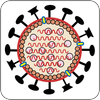
RESEARCH
VIRAL EVOLUTION

Our research is organized into three main objectives: 1) establish theoretical foundations for understanding virus escape mutations under T cell-mediated immune responses, 2) determine the extent to which theoretical concepts allow for quantitative descriptions of immune escape in model viruses, and 3) evaluate hypotheses of how immune escape characteristics affect disease pathogenesis and explore their implications for vaccine design.
Publications
Anderson, C. S., M. Y. Sangster, H. Yang, T. J. Mariani, S. Chaudhury, and D. J. Topham. Implementing sequence-based antigenic distance calculation into immunological shape space model. BMC Bioinformatics. 2020 June 19; 21(1):256. [PDF, PubMed]
Woo, H. J., and J. Reifman. Quantitative modeling of virus evolutionary dynamics and adaptation in serial passages using empirically inferred fitness landscapes. Journal of Virology. 2014 January; 88(2):1039-1050. [PDF, PubMed]
Woo, H. J., and J. Reifman. A quantitative quasispecies theory-based model of virus escape mutation under immune selection. Proceedings of the National Academy of Sciences of the United States of America. 2012 August 7; 109(32):12980-12985. [PDF, PubMed]
Woo, H. J., R. Vijaya Satya, and J. Reifman. Thermodynamic basis for the emergence of genomes during prebiotic evolution. PLOS Computational Biology. 2012 May 31; 8(5):e1002534. [PDF, PubMed]
Woo, H. J., and A. Wallqvist. Nonequilibrium phase transitions associated with DNA replication. Physical Review Letters. 2011 February 11; 106:060601. [PDF, PubMed]